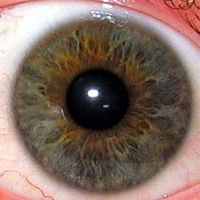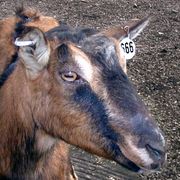Pupil
2007 Schools Wikipedia Selection. Related subjects: Health and medicine
-
The term pupil can also mean student. For the use in optics, see entrance pupil and exit pupil.

The pupil is the central transparent area (showing as black). The greenish-brown area surrounding it is the iris. The white outer area is the sclera, the central transparent part of which is the cornea.
The pupil is the variable-sized, black circular opening in the centre of the iris that regulates the amount of light that enters the eye. It appears black because most of the light entering the pupil is absorbed by the tissues inside the eye.
Comparative anatomy
In humans and many animals (but few fish), the size of the pupil is controlled by involuntary contraction and dilation of the iris, in order to regulate the intensity of light entering the eye. This is known as the pupillary reflex. In bright light, the human pupil has a diameter of about 1.5 millimeters, in dim light the diameter is enlarged to about 8 millimeters.
The shape of the pupil varies between species. Common shapes are circular or slit-shaped, although more convoluted shapes can be found in aquatic species. The reasons for the variation in shapes are complex; the shape is closely related to the optical characteristics of the lens, the shape and sensitivity of the retina, and the visual requirements of the species.
Slit-shaped pupils are found in species which are active in a wide range of light levels. In strong light, the pupil constricts and is small, but still allows light to be cast over a large part of the retina.
The orientation of the slit may be related to the direction of motions the eye is required to notice most sensitively (so a vertical pupil would increase the sensitivity of the eyes of a small cat to the horizontal scurrying of mice). The narrower the pupil, the more accurate the depth perception of peripheral vision is, so narrowing it in one direction would increase depth perception in that plane. Animals like goats and sheep may have evolved horizontal pupils because better vision in the vertical plane may be benficial in mountainous environments.
Ground dwelling snakes, such as boas, pythons and vipers, have vertical slit-shaped pupils to help them hunt prey on the ground while tree snakes have circular pupils. Small cats and foxes also have slit shaped pupils while lions and wolves have round pupils even though they are in the same family. Some hypothesize that this is because slit pupils are more beneficial for animals that hunt small prey than large prey.
When an eye is photographed with a flash, the iris cannot close the pupil fast enough and the blood-rich retina is illuminated, resulting in the red-eye effect.
Constriction of the pupil

When bright light is shone on the eye, it will automatically constrict. This is the pupillary reflex, which protects the retina from bright light, and is an important test of brainstem function. Also, the pupil will constrict if a person sees an object or a person which arouses anger or loathing.
The oculomotor nerve, specifically the parasympathetic part coming from the Edinger-Westphal nucleus, terminates on the circular iris sphincter muscle. When this muscle contracts, it reduces the size of the pupil.
Certain drugs cause constriction of the pupils, such as heroin.
Another term for the constriction of the pupil is miosis. Substances that cause miosis are described as miotic.